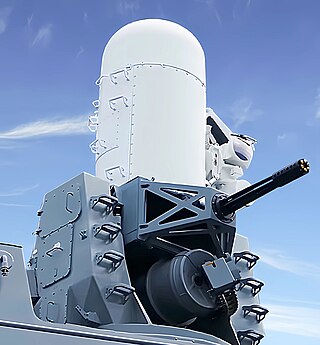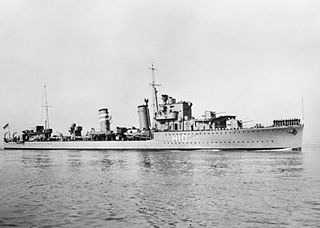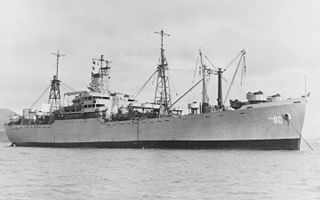
The Phalanx CIWS is a gun-based close-in weapon system to defend military watercraft automatically against incoming threats such as aircraft, missiles, and small boats. It was designed and manufactured by the General Dynamics Corporation, Pomona Division, later a part of Raytheon. Consisting of a radar-guided 20 mm (0.8 in) Vulcan cannon mounted on a swiveling base, the Phalanx has been used by the United States Navy and the naval forces of 15 other countries. The US Navy deploys it on every class of surface combat ship, except the Zumwalt-class destroyer and San Antonio-class amphibious transport dock. Other users include the British Royal Navy, the Royal Australian Navy, the Royal New Zealand Navy, the Royal Canadian Navy and the US Coast Guard.

The Albion-class landing platform dock is a class of amphibious warfare ship in service with the Royal Navy. The class consists of two vessels, HMS Albion and HMS Bulwark, ordered in 1996 to replace the ageing Fearless class. Both ships were built by BAE Systems Marine at the former Vickers Shipbuilding and Engineering yard in Barrow-in-Furness. Albion was commissioned in 2003 and Bulwark in 2004. Each of the ships has a crew of 325 and can accommodate up to 405 troops. Thirty-one large trucks and thirty-six smaller vehicles and main battle tanks can be carried inside the vehicle deck. To disembark troops and vehicles, the vessels are equipped with eight landing craft.

The E and F-class destroyers were a group of 18 destroyers built for the Royal Navy during the 1930s. The ships were initially assigned to the Home Fleet, although they reinforced the Mediterranean Fleet during the Italian invasion of Abyssinia of 1935–36 and enforced the Non-Intervention Agreement during the Spanish Civil War of 1936–1939. After the beginning of the Second World War in August 1939, the E-class ships were mostly assigned to escort duties under the Western Approaches Command, while the Fs were assigned to escort the ships of the Home Fleet. Between them they sank four German submarines through March 1940 while losing only one ship to a submarine.

The Nikon F-mount is a type of interchangeable lens mount developed by Nikon for its 35mm format single-lens reflex cameras. The F-mount was first introduced on the Nikon F camera in 1959, and features a three-lug bayonet mount with a 44 mm throat and a flange to focal plane distance of 46.5 mm. The company continues, with the 2020 D6 model, to use variations of the same lens mount specification for its film and digital SLR cameras.

Type C2 ships were designed by the United States Maritime Commission (MARCOM) in 1937–38. They were all-purpose cargo ships with five holds, and U.S. shipyards built 328 of them from 1939 to 1945. Compared to ships built before 1939, the C2s were remarkable for their speed and fuel economy. Their design speed was 15.5 knots (28.7 km/h), but some could make 19 knots (35 km/h) on occasion. The first C2s were 459 feet (140 m) long, 63 feet (19 m) broad, and 40 feet (12 m) deep, with a 25-foot (8 m) draft. Later ships varied somewhat in size. Some, intended for specific trade routes, were built with significant modifications in length and capacity.
Qasr-e Shirin is a city and capital of Qasr-e Shirin County, Kermanshah Province, Iran. At the 2006 census, its population was 15,437, in 3,893 families. It is an FTZ and is populated by Kurds.

Eyvan is a city in and capital of Eyvan County, Ilam Province, Iran. At the 2006 census, its population was 27,752, in 6,010 families. The city is populated by Kurds who speak the Kalhori variety of Kurdish.

The Pauk class is the NATO reporting name for a class of small patrol corvettes built for the Soviet Navy and export customers between 1977 and 1989. The Russian designation is Project 1241.2 Molniya-2. These ships are designed for coastal patrol and inshore anti-submarine warfare. The design is the patrol version of the Tarantul class which is designated Project 1241.1, but is slightly longer and has diesel engines. The ships are fitted with a dipping sonar which is also used in Soviet helicopters.

USS Agenor (ARL-3) was one of 39 Achelous-class repair ship landing craft repair ships built for the United States Navy during World War II. Named for Agenor, she was the only U.S. Naval vessel to bear the name.

The Active-class cruisers were a trio of scout cruisers built for the Royal Navy shortly before the First World War. They were initially assigned to the First Fleet and became destroyer flotilla leaders in 1914. Amphion and Fearless and their flotillas were assigned to the Harwich Force when the war began in August 1914. They went out on a patrol on the first day of the war and Amphion and her destroyers encountered and sank a German minelayer. On the voyage home, the cruiser struck a mine laid by the German ship and sank. She was the first ship of the Royal Navy to be sunk in the war.

HMS Fearless was one of three Active-class scout cruisers built for the Royal Navy shortly before the First World War. Upon completion in 1913, the ship was assigned to the 1st Light Cruiser Squadron (LCS) of the 1st Fleet. She became flotilla leader of the 1st Destroyer Flotilla (DF) shortly before the start of the war in August 1914 and was transferred to the Harwich Force shortly after it began. Fearless participated in the Battle of Heligoland Bight and the Cuxhaven Raid later that year. The ship was transferred to the Grand Fleet in early 1915 and played a minor role in the Battle of Jutland the following year.

HMS Fearless was an F-class destroyer built for the Royal Navy during the 1930s. Although assigned to the Home Fleet upon completion, the ship was attached to the Mediterranean Fleet in 1935–36 during the Abyssinia Crisis. During the Spanish Civil War of 1936–1939, she spent time in Spanish waters, enforcing the arms blockade imposed by Britain and France on both sides of the conflict. Several months after the start of the war in September 1939, Fearless helped to sink one submarine and sank another one in 1940 during the Norwegian Campaign. She was sent to Gibraltar in mid-1940 and formed part of Force H where she participated in the attack on the Vichy French ships at Mers-el-Kébir and the bombardment of Genoa. Fearless helped to sink one final submarine in 1941 and escorted many Malta convoys in the Mediterranean before she was torpedoed by an Italian bomber and had to be scuttled on 23 July 1941.

The Fearless-class patrol vessels were built by Singapore Technologies (ST) Marine for the Republic of Singapore Navy (RSN) in the 1990s. Four remain in service with the RSN as modified Sentinel-class Maritime Security and Response Vessels (MSRVs), while derivatives of the type are also in service in the navies of Brunei, Oman and the United Arab Emirates.

The Abhay-class corvettes of the Indian Navy are the customised variants of the Soviet Pauk-class corvettes. The class was primarily intended for coastal patrol and anti-submarine warfare. Last ship of the class is expected to be decommissioned till 2025.
Eslamabad-e Gharb, is a city and capital of Eslamabad-e Gharb County, Kermanshah Province, Iran. At the 2006 census, its population was 89,430, in 20,956 families. It is the second largest city in the province and is known for its oak trees.

India–Madagascar relations refers to the current and historical relationship between India and Madagascar. India has an embassy in Antananarivo and Madagascar has an embassy in New Delhi.














